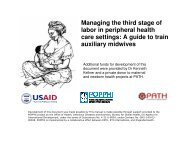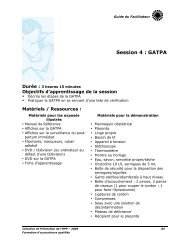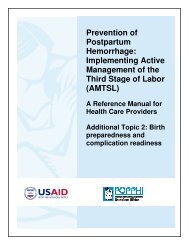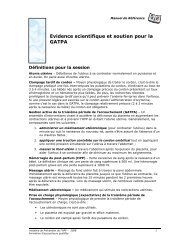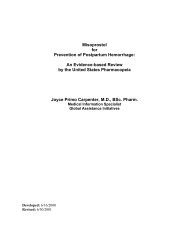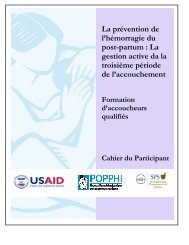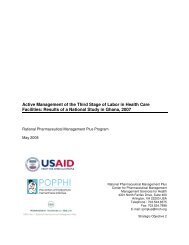El Salvador - Active Management of the Third Stage of Labor - POPPHI
El Salvador - Active Management of the Third Stage of Labor - POPPHI
El Salvador - Active Management of the Third Stage of Labor - POPPHI
You also want an ePaper? Increase the reach of your titles
YUMPU automatically turns print PDFs into web optimized ePapers that Google loves.
Tables and FiguresFigure 1.1 Determinants <strong>of</strong> <strong>the</strong> routine use <strong>of</strong> AMTSL................................................................................6Table 3.1 Availability and storage conditions for <strong>the</strong> uterotonic drugs at <strong>the</strong> central warehouse ..............12Table 3.2 Percent <strong>of</strong> health facilities with available pharmacies and supplies ...........................................13Table 3.3 Percent <strong>of</strong> facilities procuring oxytocin, ergometrine and misoprostol and percent distribution<strong>of</strong> procured drugs by recommended and observed storage conditions .......................................................14Table 3.4 Percent <strong>of</strong> facilities procuring oxytocin, ergometrine and misoprostol by costs and stock <strong>of</strong>uterotonic drugs ..........................................................................................................................................15Table 4.1 Percent distribution <strong>of</strong> observed deliveries by characteristics <strong>of</strong> <strong>the</strong> health facility and <strong>the</strong>woman.........................................................................................................................................................17Table 4.2 Percent distribution <strong>of</strong> deliveries by correct use <strong>of</strong> oxytocin for AMTSL purposes .................19Table 4.3 Percent distribution <strong>of</strong> observed deliveries by use <strong>of</strong> oxytocin for AMTSL purposes and bycharacteristics <strong>of</strong> <strong>the</strong> facility and woman....................................................................................................21Table 4.4 Percent <strong>of</strong> deliveries with controlled cord traction and uterine massage following delivery <strong>of</strong><strong>the</strong> placenta .................................................................................................................................................22Table 4.5 - Percentage <strong>of</strong> observed deliveries with correct AMTSL use ...................................................23Figure 4.1 Percent <strong>of</strong> deliveries with use <strong>of</strong> a uterotonic drug during <strong>the</strong> third or fourth stage <strong>of</strong> labor,plus additional components <strong>of</strong> AMTSL......................................................................................................24Table 4.6 Percent distribution <strong>of</strong> <strong>the</strong> duration between delivery <strong>of</strong> <strong>the</strong> baby and cord clamping..............24Table 4.7 Average duration <strong>of</strong> <strong>the</strong> third stage <strong>of</strong> labor by AMTSL use ....................................................25Figure 4.2 Percent <strong>of</strong> deliveries with potentially harmful practices ..........................................................26v



